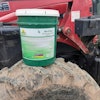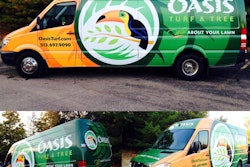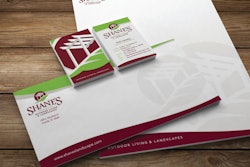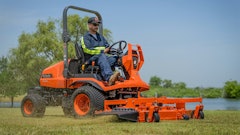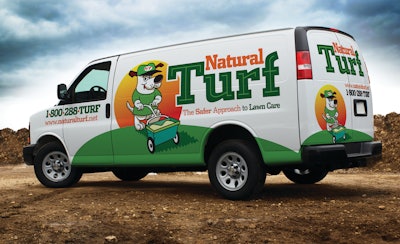
According to branding expert Dan Antonelli, most small-business brands—including landscape companies— are perceived to be either negative or neutral in the minds of most consumers. In other words, most brands aren't leaving a positive impression.
Take business cards, for example. Antonelli says nine out of 10 cards miss a huge opportunity to really move the consumer. The cards lack a point of distinction and fail to set a level of expectation. There's no unique color scheme, and the design itself falls flat. Most importantly, the card does not integrate the company's branding in a meaningful way.
"For our clients, we like to use a thicker card stock, rounded corners and satin finishes, and sometimes we even do things like spot-UV printing," Antonelli relates. "The point is that, at that moment in time when the consumer looks at the business card, they haven't seen anything like it. Right off the bat there is a brand promise that is already being communicated by that one simple thing."
This same concept carries over to other things like stationary, invoices, brochures, websites and emails; things that "touch" the customer. In this day and age, social channels such as Facebook, YouTube and Twitter must also be considered. And then there are your trucks, uniforms, etc. Branding has to be unique—and consistent.
"One thing we always talk about is the integration of branding in a consistent manner across all deliverables," Antonelli says. "When all of the consumer touch points with your company are taken collectively as a whole, that's when you can really start to draw a brand promise for your company. Your brand experience has to be very well coordinated so that anytime a consumer interacts with your company, their brand experience is the same." Why is this important? It helps to mold a positive perception and ultimately develop trust in your company.
Logos that make a meaningful impression
When establishing your brand—and more specifically creating your logo and slogan—it's important to find a balance somewhere between "me too" and "too weird". You want your logo to stand apart from other landscape companies. At the same time, it must resonate with your target customer.
"Many years ago, I was designing a logo for a landscape firm here in New Jersey," Antonelli shares. "One concept we pitched had a butterfly integrated into the logo. The client said, 'That doesn't really fit who we are, and my guys aren't going to want to wear a T-shirt with a butterfly on it.' But it's not a question of what you personally would like. It's more important to appeal to your target demographic." In this case, the contractor's target customer was a 40- to 50-year-old affluent female looking to spend around $50,000 to put a really nice patio in her backyard. Hence, the butterfly was right on—and the contractor's new logo worked wonders for him.
Another more recent example is the work Antonelli did for Ohio contractor Rob Reindl of Oasis Turf & Tree. Oasis is a great lawn care company with a strong track record of growth, but Reindl still wanted to work on his branding. "We'd introduced the idea of incorporating a toucan (tropical bird) into the logo," Antonelli says. "That stemmed from the creation of a new tagline, 'Wild about your lawn.'"
The point is that you should consider thinking outside of the box when creating a logo design. Consider playing off of the slogan you also come up with. And above all else, design with your target audience in mind.
Brand integration for your vehicles
Once you have a winning logo, you have to be diligent in incorporating it into all of your customer touch points, as pointed out earlier. Do not forget your vehicles.
"When you see a lot of landscape trucks nowadays, they don't integrate their branding very well," Antonelli says. "Often I see big photos on trucks. We're not a big proponent of that. Photographs of nice lawns and landscapes don't represent your brand. People see you drive by and say, 'Oh, that company must do landscaping.' But most people won't make the connection with your brand. That's why it's more important to integrate your brand into your vehicle advertising (i.e. truck wraps)."
The bigger problem is that a lot of landscape companies don't have a good brand (logo) to begin with. So step one is to get a good brand logo, and step two is to incorporate it into your vehicle advertising.
Step three, then, is to resist the urge to put too much wording on your truck wrap. You might want to list all 20 services you offer, for example, but who's going to read them in the finite amount of time they have as you drive by? Too many words also diminishes the impact your brand is going to have on the consumer. "We recommend the brand (logo), a tagline or slogan, website and phone number," Antonelli says. "We aren't big on bullet points either. Just keep things simple and obvious."
Brand integration for your website
Your brand must be consistently integrated into each page on your site—from the home page right on through to the contact-us page.
A good example of this is valleygreenlandscape.com, a Massachusetts company Antonelli has worked with. Sure, the company's elegant new logo is prominently displayed atop each of the website's pages, but there is far more in play. The logo is also consistently displayed in the rotating photos on the home page (on the aprons the people are wearing). Then, components of the logo (the green leaves and artistic, "swirly" line element) carry throughout the site. Finally, strategically selected fonts are consistent across all pages.
"We're not a big fan of template-based websites," Antonelli adds. "Aside from your logo you drop in, nothing else is really unique to your brand on the site." So just like when developing your branding/logo in the first place, go for originality and consistency—with your target audience in mind.
How to leverage branding perception to build profitability
Solid, consistent branding can help you stand out and build awareness in your market. But at the end of the day, what you really want to do is increase sales and, if you're lucky, profitability. According to Antonelli, effective branding can help you do that.
"Good branding helps you establish your value proposition," Antonelli explains. "If Mrs. Smith gets three estimates, for example, and the other two companies have unprofessional, inconsistent branding, right away Mrs. Smith will more than likely conclude that you will do a better job."
Many of the companies Antonelli ends up working with are at the higher end of the price scale. But they don't always look like they deserve to be charging a price premium. That's a big reason why they come to Antonelli. "If you look like you're professional and are going to be in business next year, most consumers are willing to pay a bit of a premium because there is a higher level of expectation that is established," Antonelli says.
"The tough thing about landscaping, especially maintenance, is that it is often perceived to be commodity-based," Antonelli adds. If you want to charge the customer more, you have to give them a reason. Paying you a little bit more might be in the customer's best interest, but you need to make the case. Professional, consistent branding opens the door for you to make that case.
Tips for selecting a reputable design team
Thinking you need to work on your branding a bit? You'll probably want to enlist some help. Antonelli offers the following advice for those of you looking to hire an expert to design your company logo and improve your branding.
Look to their experience. Make sure they've spent a lot of time working with small businesses, and specifically landscape companies if possible. That way they'll have a better understanding of the marketing challenges you face so they can better create and integrate your brand across all of your customer touch points.
Don't assume your web designer can do it. He or she might be graphically inclined and effective at designing websites, but that might not translate over to business cards, uniforms, truck wraps, etc.
Find out who will actually do the work. An agency might show you great work it has done in the past, but sometimes the employee who did that work is no longer there.
Additionally, be leery of crowdsourcing, which is the practice of obtaining services by soliciting contributions from a large group of people, such as an online community, rather than from traditional suppliers such as a marketing agency. With crowdsourcing, won't know who is tasked with developing your branding and you won't be able to talk with them. Often the person is in another country, such as Russia. What would he or she know about branding a landscaping company in the U.S.?
Demand original work. Ask to see your branding as it is developed. It would be really frustrating if you hired someone to develop a logo for you, only to find out three months later that the designer stole a piece of art from someone else, forcing you to stop using that logo. Another example would be that the designer uses generic graphics from stock photo libraries or clip art. Here the risk is that your logo ends up looking very similar to someone else's. Plus, you could never get your logo trademarked if it isn't truly original.




